Mareinoa: a proa for cruising
A report on a new cruising proa build by Manfred Meier, designed by Othmar Karschulin of multihull.de. Thanks to Manfred and Othmar for the submission! —Editor
I became aware of the proa when reading a book about multihulls, named “Mehrrumpfboote” (multihulls) written by Klaus D. Kurtz. I expected that this book would deal with catamaran and trimarans only. But instead it started with a report of William Dampier, one of the earliest European circumnavigators. He described that already in 1686 proas sailed 1200sm within only four days.
I was and I am still fascinated from the principle of a flying proa that under wind load the ama is lifted and so the draft is reduced. Because I have always been an enthusiastic boat builder I built the P5, a 5m proa designed by Othmar Karschulin. I made exciting experiences and trips with this boat and so I designed and built a second proa.
However, the experience with these boats told me that the design (asymmetric hull, no daggerboard, crabclaw rig) is not appropriate for a modern cruising yacht. So our idea, Othmars and mine, was to combine the advantages of the typical proa characteristics with modern assets. Beside the innovative material it was the leepod, the daggerboard and the rig that considers modern technologies and the mentioned requirements.
The composite construction allows the low displacement, the leepod provides good interior space (standing height 2m, double berth 1.95mx2m) and also protects from capsizing. The daggerboard enables us to point upwind well, and the rig to handle it very easily. After almost two seasons I am happy to say that our expectations have been met.
Beside the fact that a proa of this size is not a normal boat, the A-mast situated lengthwise is, at least to my knowledge, unique. The reason to build the mast in this way is to get a large cockpit without an annoying mast in the middle.
When sailing I am always impressed by the course stability. I remember one trip when I did not touch the tiller for more than one hour. Furthermore it is incredible how quiet and calm is the boat’s motion while underway. On one of the photos you see a post card. I put it there at the beginning of the season and it did not fall over during the whole summer and under all weather conditions.
The boat leads to a lot of new contacts. If you are not communicative by nature, you will become so with this boat. Almost always people stand in front of the boat and ask what this exotic thing may be and how all the features may work. One time a couple walked the whole harbor in order to visit. They first saw only the strange form of the A-mast in the forest of masts, they could not imagine what this could be but in any way it must have been very exciting. Another time a sailor asked us when we would be departing, because he wanted to follow us to see the boat in action and take some pictures.
Right from the beginning of the project it was clear that shunting would mean some effort. You have to roll up the genoa then to turn around the main, to lift the first rudder, to lower the second rudder and to roll out the second genoa. At the moment this maneuver takes almost one minute. With two well skilled people I guess it might be possible to come down to 30 seconds but still it is not comparable to tacking of a monohull. Especially when you take into consideration that the boat comes to a stop. So sailing in narrow waters will not be the preferred trip with this boat (which is no real surprise). That is a pity because there are some nice sounds around our home port Boltenhagen in the southern Baltic.
In light winds the speed is quite considerable. I measured 4.4 - 5.6 knots at 1.8 - 3.1 knots true wind. At 5-6 knots true wind the boat speed was between 6 and 9.3 knots. All this data were taken on a course close to the wind. But because of the relatively high speed this means 90 degrees to the true wind.
Specifications
Youtube video of proa sailing.
Home page: Mareinoa.de
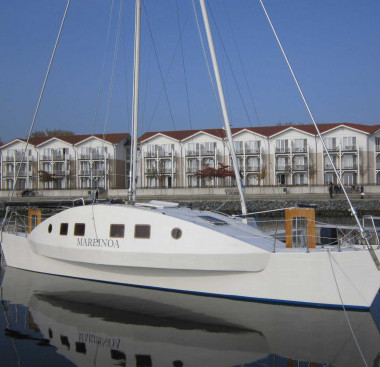
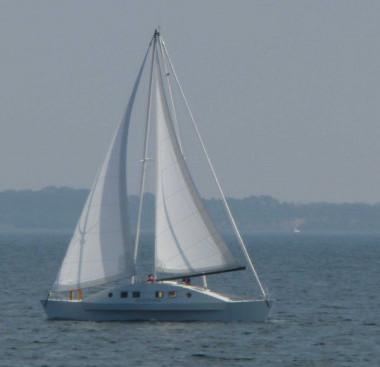
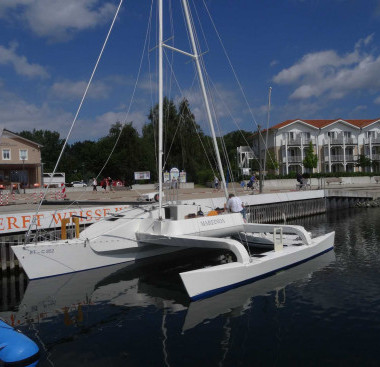
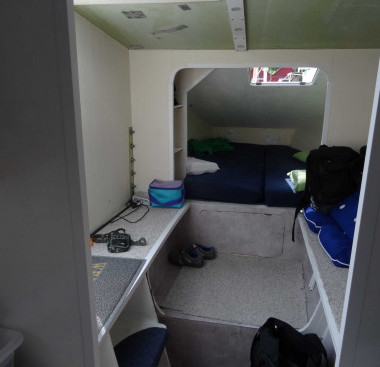
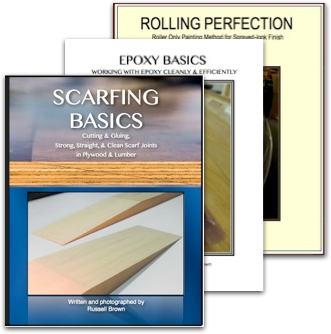
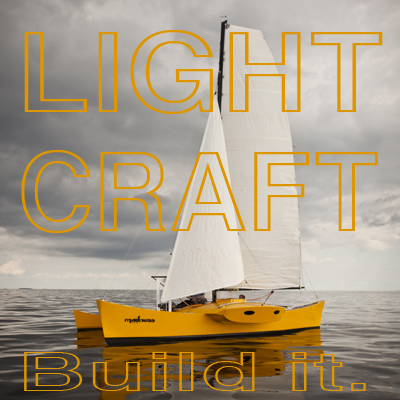
Beautiful boat